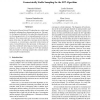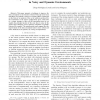3DIM
2003
IEEE
14 years 11 months ago
2003
IEEE
The Iterative Closest Point (ICP) algorithm is a widely used method for aligning three-dimensional point sets. The quality of alignment obtained by this algorithm depends heavily ...
ICRA
2006
IEEE
15 years 14 days ago
2006
IEEE
— This paper proposes a tracking system called VooDoo for 3d tracking of human body movements based on a 3d body model and the Iterative Closest Point (ICP) algorithm. The propos...
ICRA
2007
IEEE
15 years 22 days ago
2007
IEEE
— This paper presents a technique to improve the data association in the Iterative Closest Point [2] based scan matching. The method is based on a distance-filter constructed on...
3DIM
2007
IEEE
15 years 24 days ago
2007
IEEE
We describe a variation of the iterative closest point (ICP) algorithm for aligning two point sets under a set of transformations. Our algorithm is superior to previous algorithms...
3DIM
2007
IEEE
15 years 24 days ago
2007
IEEE
We present an analytical method to estimate the absolute registration error bounds if two surfaces were to be aligned using the ICP (Iterative Closest Point) algorithm. The estima...
ICRA
2008
IEEE
15 years 26 days ago
2008
IEEE
— We show how matching and reconstruction of contour points can be performed using Dynamic Time Warping (DTW) for the purpose of 3D hand contour tracking. We evaluate the perform...
IROS
2009
IEEE
15 years 1 months ago
2009
IEEE
— Time-of-Flight cameras constitute a smart and fast technology for 3D perception but lack in measurement precision and robustness. The authors present a comprehensive approach f...
MICCAI
2004
Springer
15 years 7 months ago
2004
Springer
Abstract. This paper investigates the use of a total least squares approach in a generalization of the iterative closest point (ICP) algorithm for shape registration. A new General...
MICCAI
2003
Springer
15 years 7 months ago
2003
Springer
A generalized image model (GIM) is presented. Images are represented as sets of four-dimensional (4D) sites combining position and intensity information, as well as their associat...
ICPR
2002
IEEE
15 years 7 months ago
2002
IEEE
This paper presents a new approach for 3D view registration of stereo images. We introduce a hybrid error function which combines constraints from the ICP (Iterative Closest Point...


